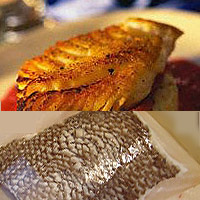Fit and Fast Recipes
Sea Bass

Varieties
Many different fish, not all related, are sold under the name of bass. Black sea bass, with its lean, firm flesh, is popular in Chinese cooking, steamed or deep-fried. Red and black groupers, the two most common kinds, are caught in temperate waters and appear in the cuisine of many Spanish-speaking countries. Most white sea bass on the market comes from Mexico. Although it is classified as in the drum family, white sea bass has firm white flesh like most members of the sea bass family. Hawaiian sea bass, called Hapu’upu’u, has dense meaty flesh. Chilean sea bass, not actually a member of the sea bass family, has large, pointed teeth and richer, softer flesh than sea bass. The Gulf coney grouper, or baquetta, lives along the West Coast of Central America and has dense, meaty flesh.
Copyright © 2025 TraceGains, Inc. All rights reserved.
Learn more about TraceGains, the company.
The information presented in the Food Guide is for informational purposes only and was created by a team of US–registered dietitians and food experts. Consult your doctor, practitioner, and/or pharmacist for any health problem and before using any supplements, making dietary changes, or before making any changes in prescribed medications. Information expires December 2025.










